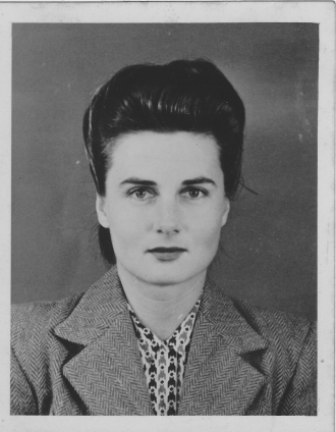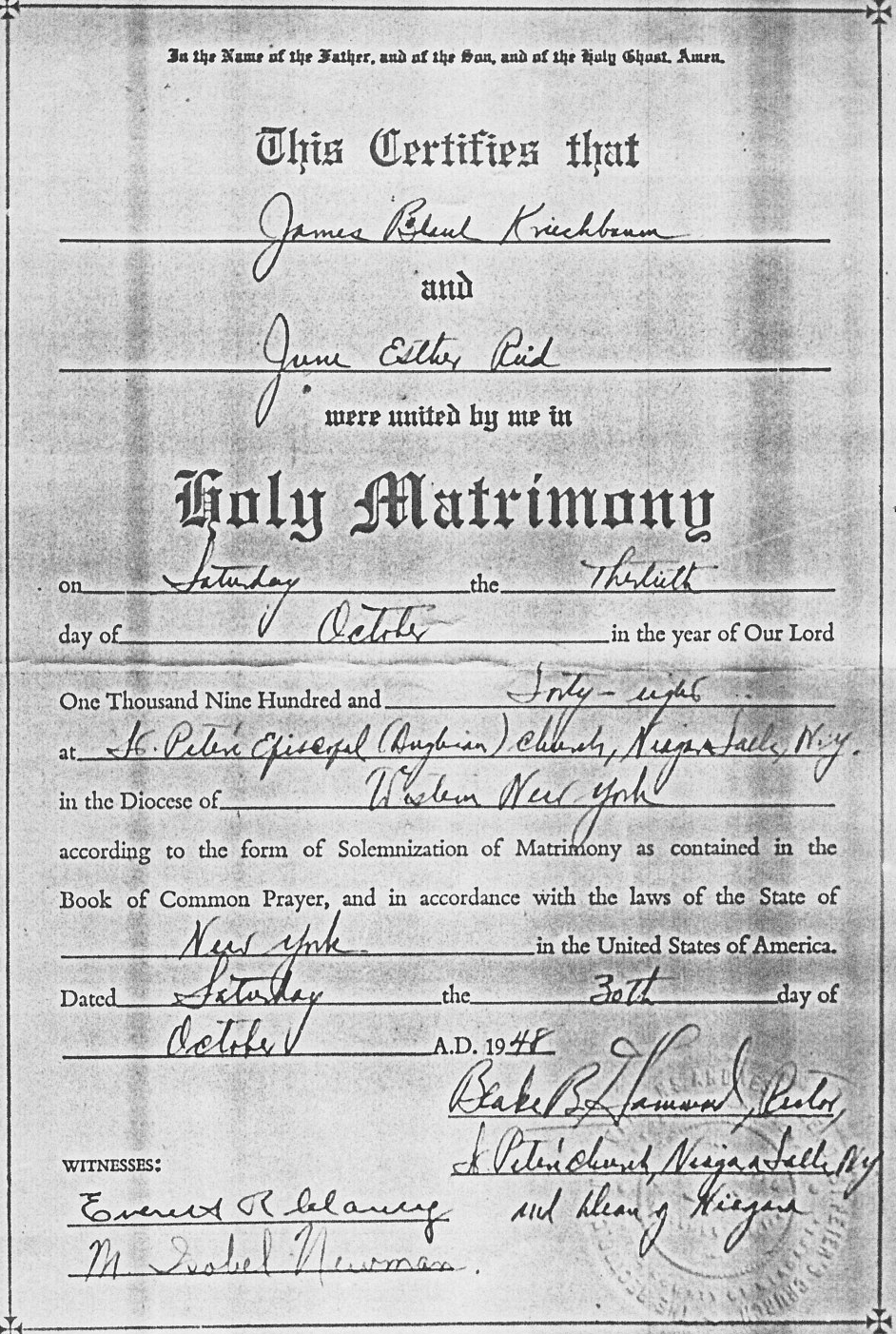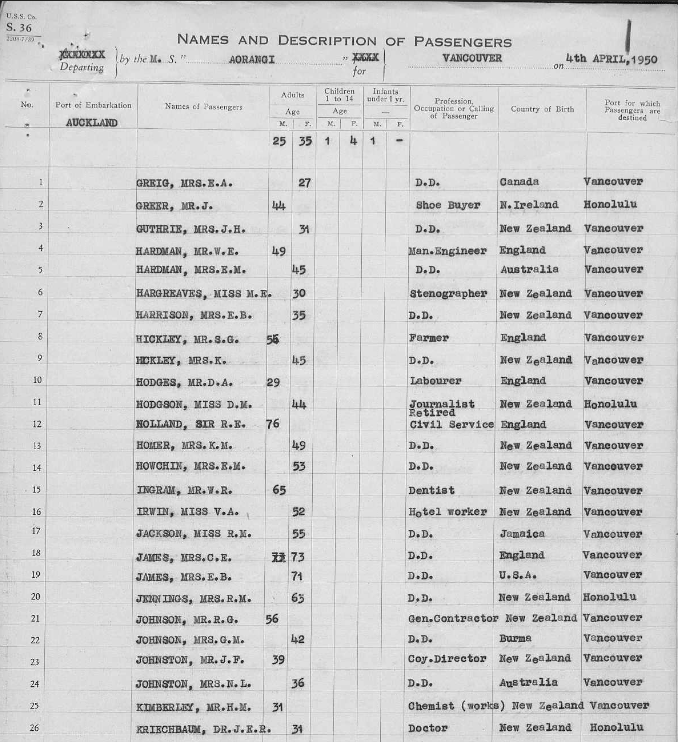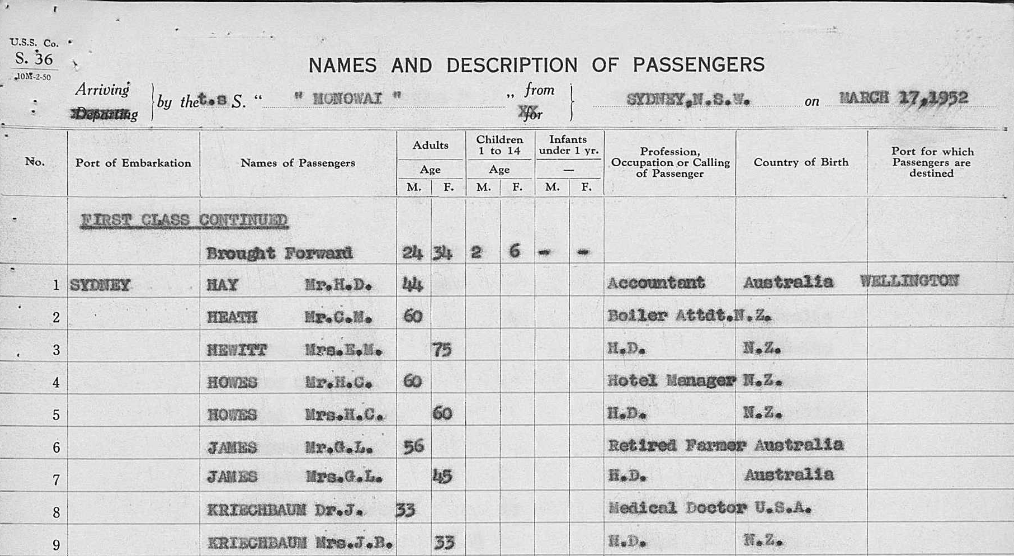This biography is based on information provided by Jim and Anthony Kriechbaum and Caroline Greig. Jim, Anthony and Caroline also provided us with a letter June wrote to her grandson detailing the early years of her life.
1944 GRADUATE
Contents
Early Life Moving Around
June Esther Reid was born in a maternity hospital in Wellington on 5 February 1919 to James Ernest and Lilian Esther Reid. June’s father was a soldier in the Boer War (1898-1900), and upon return to New Zealand, he became a sheep farmer. June was the only child of this marriage, though she had a much older half-sister from her mother’s first marriage. The family lived on a sheep farm in the King Country. “The only things I can remember about life there are riding with my father, seated in front of him on horseback, and watching my mother bake bread, which she did once a week in a black iron stove in the farmhouse kitchen. Remember, I told you we lived in a remote part of the country, nowhere near town bakeries or grocery stores (there were no supermarkets in those days, even if we had lived in town).” [June]. However, due to the depression, June’s family was forced to sell the farm around 1923. From here, the family moved to various rural towns, one of which June remembered being Whangarei. June’s father had only ever worked in farming and did not have a secondary school qualification. “He was not equipped with any skills for work other than farming. He was a simple man, honest, generous and well-liked and respected” [June]. He ended up finding work as a hotel manager. June’s only memory of Whangarei was “that it was very hot and that one day, when playing on a building site, I fell off the wooden planking and injured my back, which started the problems I have subsequently had with it” [June].
Another town they settled in for a short time was Marton, where her father managed a hotel called the White Hart. June enjoyed her time there and frequently played with the daughter of a local Maori man who worked with her father. This family had a farm, and June “used to catch tadpoles in a jar from a pond on the farm and watch them till they grew into frogs. And I helped collect dry cow pats to burn in the cottage stove – they burn beautifully, I assure you!” [June]. The Reids did not have a car and so would take a horse and buggy into town. “Early in our stay there, when I must have been about six – or less –I was to take some money to school for something, probably only about threepence and as I walked to school, I stopped at the sweet shop and went in to spend the coin I was supposed to take to school. My father used to stand outside the hotel to watch me along the road and, of course, he saw me go into the sweet shop. He immediately came along and led me back into the shop to return my ill-gotten spoils” [June].
When June was about eight and the family was in Waihi, she decided to pursue a career in medicine. “I can remember lining up my dolls in their little beds, on the verandah, and deciding that when I grew up I wanted to be a doctor – not a nurse, as you might have expected, nor a mother (that was due to change, of course!) but a doctor.” [June]. Her son, Anthony, mentioned that she had “an interest in helping people – aiding suffering people – humanitarian reasons.”
Settling Down for High School
June’s primary school education was quite disrupted due to her family moving around so much. She attended at least eleven primary schools and, as a result, had not been able to make many friends. By high school, however, they had settled in Palmerston North. “The day before I was to start high school, my father and I visited the Feilding show grounds in the morning. While we were there the big grandstand started rocking and shaking. It was the day of the Napier earthquake, a terrible earthquake that killed a lot of people and practically destroyed the town of Napier. It opened up big cracks and crevasses in the roads leading to the town, making relief work even more difficult. The town has subsequently been virtually completely rebuilt” [June].
June attended Palmerston North Girls’ High School, which was a twelve-mile bus ride from Fielding. She quickly became lifelong friends with another girl who took this same bus route – Justine Smith. She achieved academically well at all of her subjects, though she did not enjoy Math due to the teacher “who used to walk by me and slap me on the back, exhorting me to “sit up straight!”” [June]. She appreciated learning Latin for six years, though, as it was useful for learning other languages later in life – at that time, it was an obligatory subject for entrance to medical school. Her family believes her natural ability for academics must be in her blood because her maternal great-grandfather was a Professor in Manchester.[1]
Unfortunately, while in Palmerston North there was another Depression and her father lost all of his possessions. As a result, the family moved to New Plymouth. Here, she attended New Plymouth Girls’ High School. “She hated leaving Palmerston North and the friends she had made but was fortunately able to return later” [Caroline]. However, she only stayed in New Plymouth for the latter part of her fifth form year. She returned to Palmerston North Girls’ High for sixth and seventh form as a boarding student until her parents could return as well. June continued to achieve academically well and was awarded Proxime Accessit in 1936. “Times were hard and money scarce. My mother went over to Melbourne to see if there were more opportunities there but returned, having found the climate very harsh and no work” [June].
“The Depression made a lasting impression on Mum. She was very frugal and it was particularly important for food not to be wasted. I remember a dining table discussion between Mum and Dad. Dad had been brought up to leave food on the plate to show that he had been served more than sufficient food (he came from a well-off background) whereas Mum liked us all to finish what had been served up. She had learned as a child that one wasn’t quite sure when the next meal would be coming” [Caroline].
University Studies in Wellington and Dunedin
June attended Victoria University College for her Medical Intermediate Years, which she began in 1937. While in Wellington, June rented two rooms in a house not far from the university with her friend from Palmerston North, Justine. She reported that she was quite homesick for the first few months and did not especially enjoy the subjects she had to learn for Medical Intermediate (Physics, Chemistry and Biology) – her favourite subjects at school had been the languages. Outside of her subjects, however, she thoroughly enjoyed being a student, from the “discussions in the cafeteria, stimulating debates at the debating club, the student newspaper, the Glee Club (a sort of choir) and the “bob hops” – dances on Friday nights [which] cost a “bob” or one shilling to attend” [Caroline].
June passed biology and chemistry but failed physics, which meant that she had to sit a “special” exam. She passed these with the help of her friends: “Two friends coached me in that (one of them Les Gandar, who later married my friend Justine) and all was well (in fact I remember getting higher marks in the exam than either of my coaches!!” [June]. Tragically, her father passed away in September 1938 as he had been an undiagnosed diabetic, so she took a break for the rest of that year and completed various jobs, such as “manual work as an orchardist”, “demonstrating hydroponics at a big trade fair (I remember her as a keen gardener) and working in a radical bookshop in the city” [June]. During this year, she contemplated not continuing with her medical studies. However, she did persist (most likely due to her mother’s encouragement) and returned to her studies for a second year of intermediate in 1939. She made many lifelong friends at Victoria University.
“The Spanish Civil war was on around this time and she said that many of the students, including her, were very supportive of the communists – so she was quite politically motivated” [Caroline].
June passed all of her classes and entered Medical School in 1940. She took the train from Palmerston North to Wellington, then an overnight ferry to Christchurch, and then a train to Dunedin. Her family supported her financially, but she also received a Bursary and worked during the summer breaks (one of her summer jobs was fruit picking). June did not like Dunedin as much as she had enjoyed living in Wellington. She preferred the “political ambience of Victoria University … she found Otago University (medical school) far more straightforward (even dull) by comparison” [Anthony].
There were only a few women in her class, though she was fairly solitary, so she did not make any close friends. Her closest and longest friends from this time were the family she boarded with in London Street. Her social life included golf and participating in youth groups. When sorting through her mother’s things, her daughter Caroline found a number of gifts from male friends. These include inscribed books and boxes of handkerchiefs with signed cards in them. One male doctor friend also asked her to marry him. However, it appears she turned him down.
“She was a very attractive-looking young woman and according to her very dear friend (who admittedly could embellish slightly for effect!) there were times she would be chased down the street by men. I had always understood that she had dated US soldiers stationed in NZ during the war” [Caroline].
June performed well at Medical School and did not have to repeat any years. She benefited from boarding privately as it was conducive to study. Her favourite subject was Physiology. World War Two had a profound effect on her studies, and rather than having a trainee intern year, she was employed as a house surgeon to help with the war effort.
June graduated in 1944, along with seven other women. Her graduation took place in Dunedin Town Hall and her children believe that her mother came down for the celebration.

A Life-Changing Trip to Chicago
June spent the first few years after her graduation working rural GP locums in the North Island, primarily in the Rangitikei area and then as a junior doctor at Nelson Hospital. One notable locum was under Eric Roy Lange, who was David Lange’s father. After practising for four years in New Zealand, June decided to travel to England via America with Florence Scott, who was a Canadian friend. Her children believe that she may have been interested in moving to America as Wellington had been flooded with American soldiers during the war, which had impressed her. She took a boat trip from New Zealand and landed on the West Coast. Though she had originally gone to America to travel, she was fortunate enough to find work at St Luke’s Hospital in Chicago. “My brother Jim understands that Mum was a registrar in Cardiology” [Caroline]. The role was administrative because her medical qualification was not recognised in America. She would have had to have sat certain exams to convert it. At St Luke’s, she met James Blaul Kriechbaum (known as Jim) – a physician. They got to know each other and quickly fell in love.
“It all started in Chicago when my wife, June, was visiting Chicago hospitals and we met at St Luke’s Hospital. I was told to leave this lass alone as she was Dr June Reid from New Zealand and on her way to England but I rushed her around showing her Chicago and got her a job in the hospital for a while until her visitor’s Visa expired. When she returned from England via Canada we got married in Niagara Falls after much discussion. I was able to bring her back into USA again as a G.I. bride, for free”. [James Blaul Kriechbaum]
June’s visa ran out, and so she left New York on Cunard ship “Media” on 4 September 1948 for England. She believed that Jim was heading to Burlington, Iowa (which was his home town), to check on his father. On 21 September, June visited the US Embassy in England to apply for a US Immigration Visa, which would allow her indefinite stay and ability to work; rights that she did not have on the Visitor’s Visa she had originally come to America with. She listed Jim as her contact and referred to him as a “friend” not “fiance”, otherwise she would have had to marry him upon arrival in America. She sent him the documents he needed to fill out as her reference and advised him that she had looked into what was required for her to practice in Canada. “Passage on a ship from England to NZ was not available for over 1 year at that time, whereas it was much easier from Canada or US – so Mum could get back to NZ from N America if their relationship didn’t work out” [Caroline].

In October 1948, June was in Canada, and after spending some time together, June and Jim decided to marry. They got married on 30 October 1948 in a small church (St Peter’s Episcopal Anglican Church, New York State) at Niagara Falls, using some people they met on the street as witnesses. They then returned to America, claiming that she was a bride from the war. Because she was unable to work in America, they decided to move elsewhere in the world. For a relatively long time, they struggled to find a country where they could both practise and so lived separately.
Living Apart: Letter Writing Between February 1949 and March 1950
In February 1949, the Kriechbaums came to New Zealand, where Jim met his future partner who had been looking for a younger eye associate. In May, June travelled to Wellington for a health examination for her American visa. This has to be done by a doctor approved by the US Government. At the same time, Jim was on a boat heading to Chicago via Sydney and Melbourne. This was so that he could continue working for his Boards in Ophthalmology. During their time in different countries, June and Jim constantly wrote detailed letters to each other. Their children still have these letters, which outline exactly what was happening and the difficulties they experienced trying to be in the same country.
In mid-August 1949, June was still waiting to hear back about her visa and was undertaking a GP locum. She mentioned that it was good to be back practising after more than two years of absence. After this locum was complete, she moved to Christchurch for another locum, which lasted until 30 August. Upon completion of her time in Christchurch, she returned to the GP practice she had completed a locum at in August.
On 11 September 1949, June wrote a letter to Jim advising that she was going to Tauranga for a few days to complete a locum. She mentioned that she had received two job offers: (1) an assistantship with view to partnership in an outlying suburb of Auckland, and (2) Assistant Medical Superintendent at a hospital in Apia, Western Samoa. June was grateful to be offered these jobs as they provided financial stability. It also gave her the opportunity to help her mother, who had been experiencing financial problems. It does not appear that she accepted these positions, however, as she continued to do locum work. During September, Jim was spending his time between Chicago, where he was preparing for his Board Examinations, and Burlington, where he was sorting the estate of his late father.
In October 1949, June mentioned that her mother’s health was failing, so she temporarily moved her into a rest home in Auckland for one to two weeks so that she could be properly cared for as she recuperated. In November 1949, June completed a two-week locum at Eketahuna. On 15 January 1950, June mentioned to Jim that she had received a few more offers of work: three locums ranging from 1-6 months, one locum that would last 12 months, and an assistantship. The next day she began a two-week locum in Wellington. They both continued to discuss the possibility of working in Canada.

In March 1950, Jim sent money to June to cover her fares to America. June departed Auckland on 4 April 1950 on the “Aorangi”. The ship was bound for Vancouver, but June’s destination port was listed as Honolulu. After landing in Honolulu she travelled to Chicago to meet Jim. Though the letters end here, Caroline believes June remained in Chicago until at least June 1950 (quite possibly longer), when Jim’s contract in Chicago was due to end, and he would receive his American Boards in Ophthalmology. He was offered further work at St Luke’s, though the couple decided to move to London so he could sit his English Boards. The letters mention that he was undertaking his studies in 1951. Passenger lists indicate that the couple returned to New Zealand from March to August 1952, presumably to visit June’s mother. They boarded the “Orion” in England and then transferred to the “Monowai” in Sydney, arriving on 17 March in New Zealand. In mid-August 1952, they departed Wellington on the “Rangitane”, which was bound for Southampton – but the “port at which passengers have contracted to land” was listed as Panama. Presumably, they continued on to London, as Jim kept a letter dated March 1953 which placed them at their home in London. Notably, he attracted much attention as the couple was living on Harley Street (a street famous for private specialists in medicine), but he was not allowed to be working. In 1953, June gave birth to their first son, Anthony.

Starting a Family & Picking Up Hobbies

The Kriechbaums returned to New Zealand in March 1955 on the “S.S. Orsova” when Jim was fully qualified and allowed to work in the Commonwealth, and the family continued to grow. In total, Jim and June had five children (Anthony, Chris, Caroline, Jim and Sara), during which time June did not work so that she could support her family. She did consider going back to work after the last child had moved out, however, by this time, “she had not practiced for 20-25 years and it felt too daunting to get herself up-to-date so she did not pursue it” [Caroline]. She was content that Jim was the breadwinner and her children recall there being “a good amount of medical discussion in the house”. Two of her children followed in their parents’ footsteps and went to medical school. In her spare time, she pursued other hobbies. She took up languages again, becoming fluent in Spanish, French, and Italian and teaching her grandchildren Latin. She attended classes well into her later life and only stopped due to hearing difficulties.
“Mum was a keen gardener, and a most hospitable cook. She was active with her Anglican parish (Saint Aidan’s, Remuera, Auckland) and in charity work. She maintained a keen (and lifelong) interest in everybody’s life and progress – and communicated well (spoken and written word) with everyone, until late in to old age. She suffered with moderate (to severe) deafness in the last years of her life, and this of course affected communication” [Anthony].
June passed away peacefully on 26 January 2017 at Caughey Preston Hospital.
[1] This information comes from the headstone of June’s relative: Esther Ann Whitehead (nee Butterworth), which reads: “Esther Ann Whitehead dearly loved mother of Ethel Whitehead and daughter of the late Professor Butterworth, Lecturer Manchester”.
